Physical Address
304 North Cardinal St.
Dorchester Center, MA 02124
Microdiscectomy
Foraminotomy
Laminectomy
Posterolateral fusion (PLF), posterior lumbar interbody fusion (PLIF), transforaminal lumbar interbody fusion (TLIF)
Vertebroplasty, kyphoplasty
Lumbar osteotomies
Lateral lumbar interbody fusion (LLIF)
Oblique lumbar interbody fusion (OLIF)
Anterior lumbar interbody fusion (ALIF)
Lumbar disc arthroplasty
The lumbar spine usually consists of five vertebrae, although anatomical variations with either four or six lumbar vertebrae can exist in a small percentage of individuals. The vertebral canal is bound anteriorly by a vertebral body and intervertebral disc, dorsally by laminae, and laterally by pedicles and facet joints. The lumbar pedicles are thick, cylindrical bony structures that arise from the rostral half of the dorsolateral aspect of the vertebral body and connect the body to the posterior spinal elements ( Fig. 34.1 ). The axial angle of the lumbar pedicles increases as they descend, from almost straight at L1 to a much more lateral–medial orientation at L5, which is clinically important during pedicle screw placement ( Fig. 34.2 ). The nerve roots exit laterally in the foramen just below the pedicles at each level. The intervertebral disc (anteriorly) and the bilateral facet joints (dorsally) share and transmit the biomechanical load.
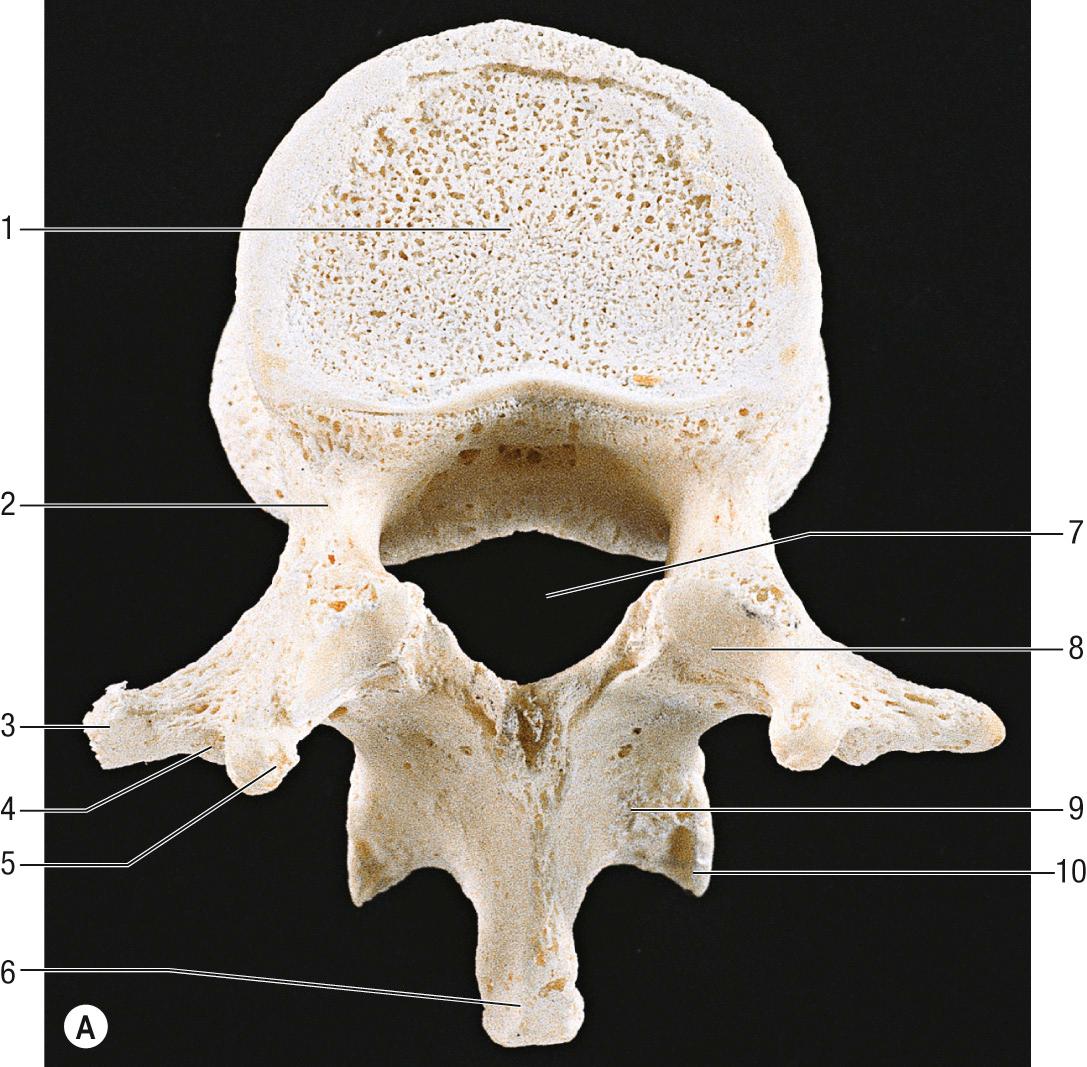
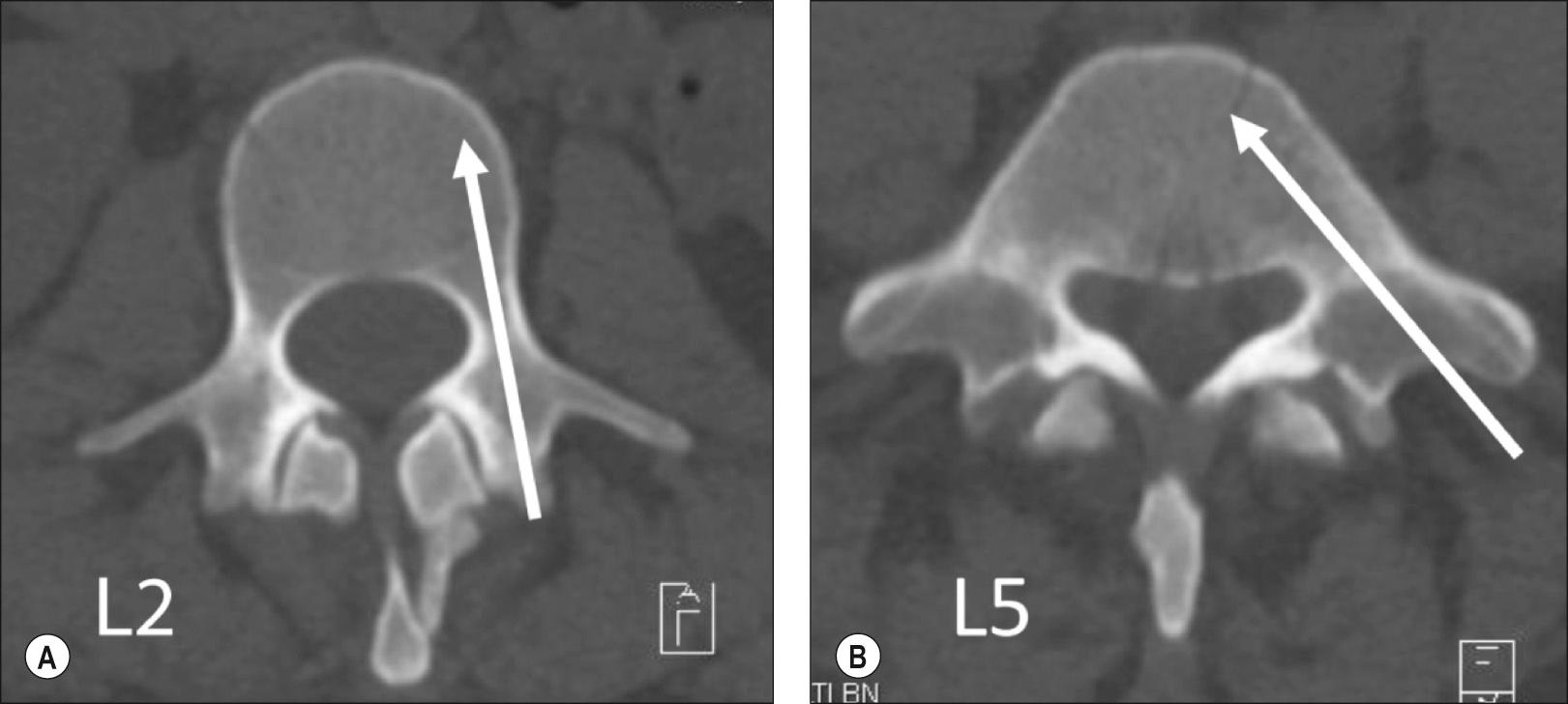
The superior and inferior articular processes from adjacent levels form the facet joints, also known as the ‘zygapophysial joints’, which are synovial joints with important biomechanical roles. The pars interarticularis is the portion of bone that bridges the superior and inferior articular processes at a given spinal level. Pars fractures, also known as ‘spondylolysis’ ( Fig. 34.3 ), are present in approximately 6% of adolescents and usually affect L5 ; they can be associated with anterior subluxation of the corresponding vertebra, causing ‘isthmic spondylolisthesis’. The ligamentum flavum is a paired ligament running between adjacent laminae of the vertebral bodies and forming part of the posterior ligamentous complex of the vertebral column. On each side, it originates from the mid portion of the anterior surface of the upper lamina and inserts into the rostral lip of the lamina of the vertebra below ( Fig. 34.4 ). In the lumbar region it extends laterally, forming the anterior portion of the facet capsule. Understanding the anatomy of the ligamentum flavum is extremely helpful during lumbar decompression procedures.
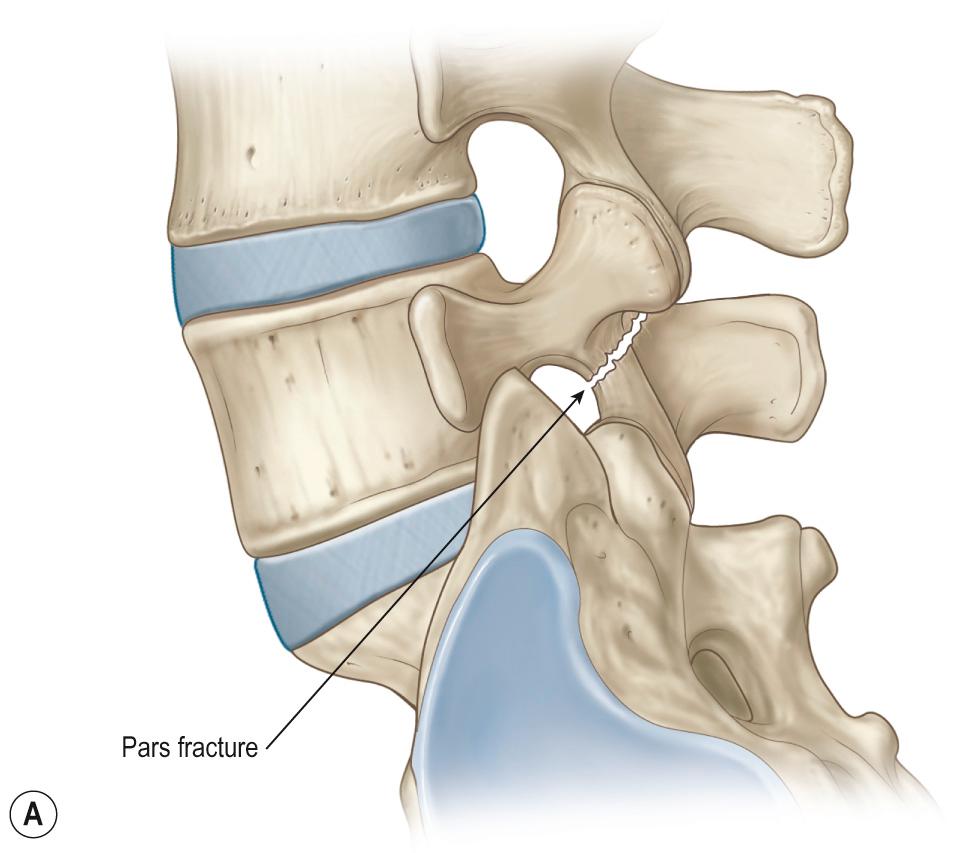
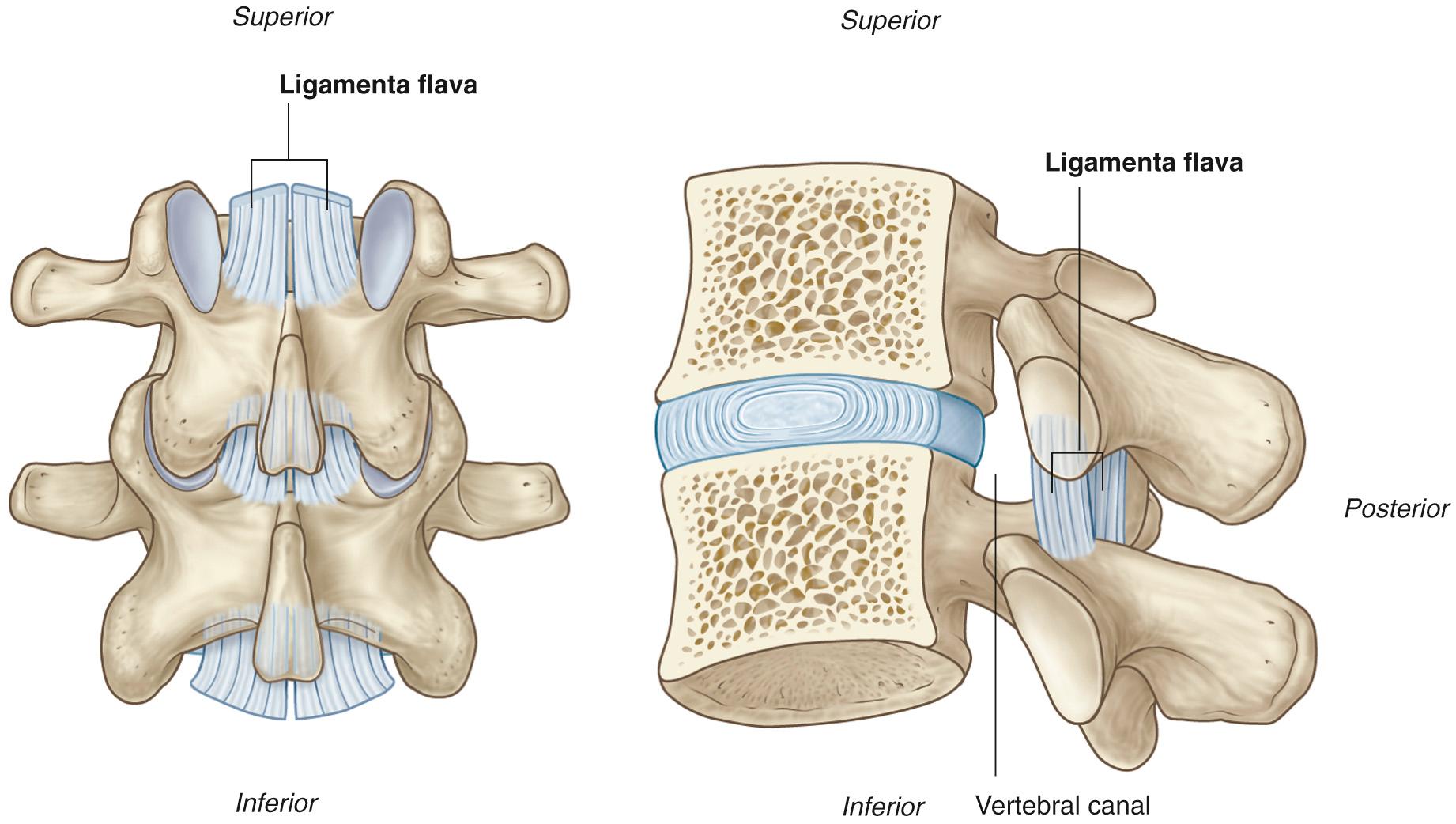
The intrinsic paraspinal muscles are usually detached from their bony attachments in the midline to provide surgical exposure and to obtain an adequate surgical corridor. Minimally invasive approaches utilizing tubular dilators can minimize tissue trauma by splitting the muscle fibres while preserving the muscles and their bony attachments. The erector spinae muscle contains three columns from lateral to medial, including iliocostalis, longissimus and spinalis ( Fig. 34.5 ); these intrinsic paraspinal muscles are responsible for extension and lateral bending of the lumbar spine. Quadratus lumborum is located anterolateral to erector spinae; it originates from the iliac crest and iliolumbar ligament, and is attached superiorly to the lower anterior surface of the twelfth rib, the lateral surface of T12, and the apices of the transverse processes of the upper four lumbar vertebrae, forming part of the posterior abdominal wall. Psoas major is a long muscle lying on either side of the lumbar vertebral column and the pelvic brim. It has a complex origin that includes the anterior surfaces and lower borders of the transverse processes of all the lumbar vertebrae and five digitations from the bodies of adjoining vertebrae and their intervertebral discs. The lumbar ventral rami that form the lumbar plexus pass laterally into the posterior part of the muscle, anterior to the transverse processes of the lumbar vertebrae. Psoas major descends along the pelvic brim, continues posterior to the inguinal ligament and anterior to the capsule of the hip joint, and converges to a tendon (joined on its lateral side by most of the fibres of iliacus) before attaching to the lesser trochanter of the femur. Quadratus lumborum and psoas major are important anatomical landmarks during the lateral transpsoas approach to the spine ( Fig. 34.6 ).
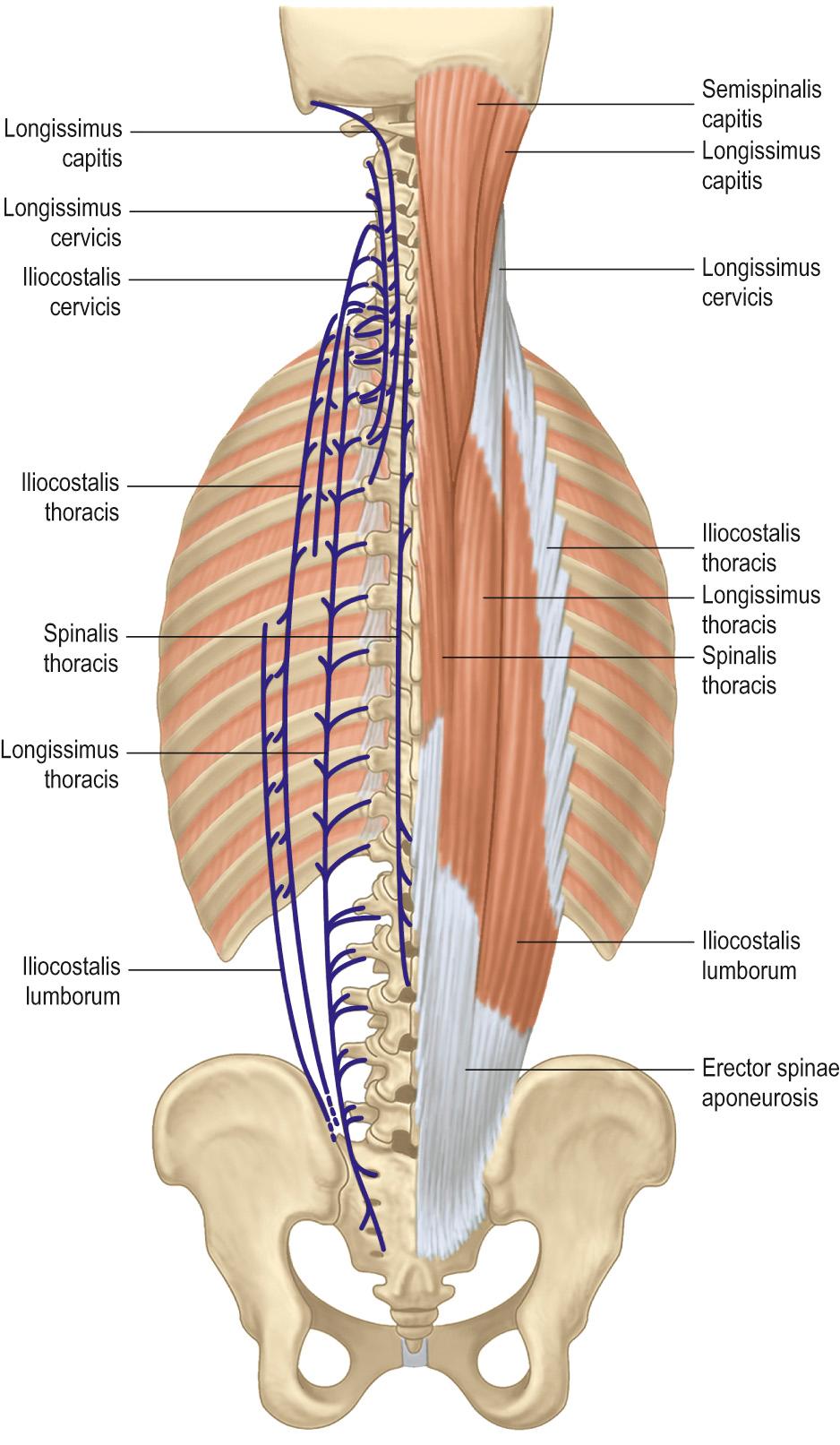
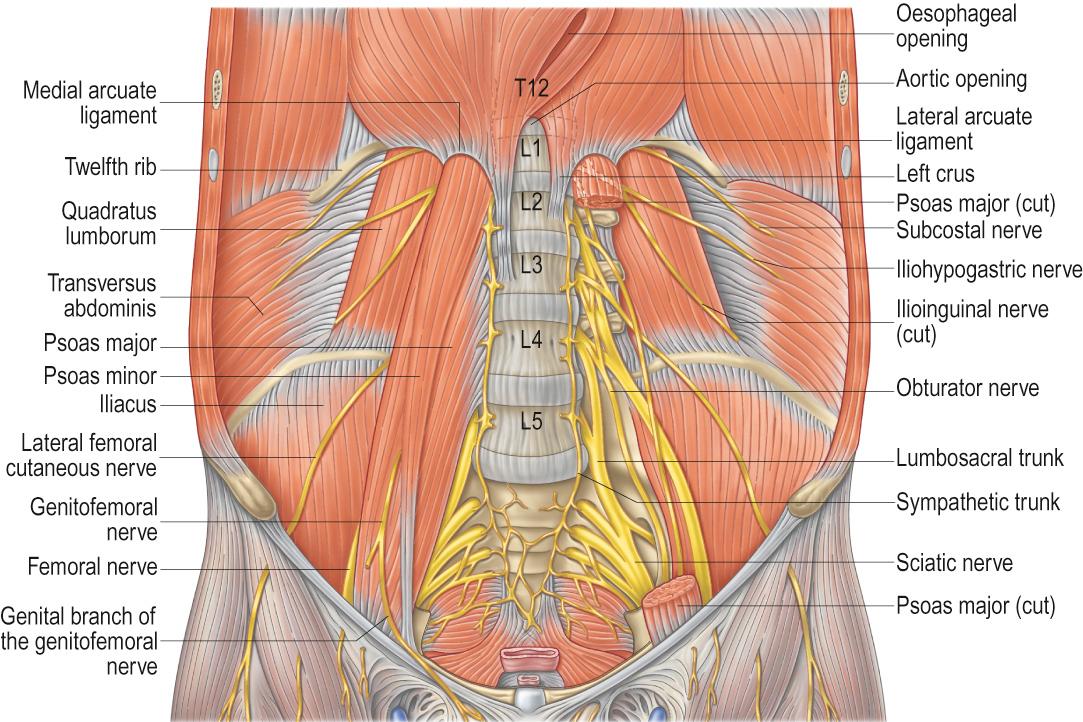
The relevant extrinsic muscles for the anterior approach in the lumbar region include rectus abdominis, external oblique, internal oblique and transversus abdominis ( Fig. 34.7 ) . Rectus abdominis is a paired, long, strap-like muscle that extends along the entire length of the anterior abdominal wall on either side of the linea alba; it originates from the middle ribs and inserts into the pubis to form the middle portion of the anterior abdominal wall. External oblique, internal oblique and transversus abdominis are located lateral to rectus abdominis, from superficial to deep; they are important during lateral and anterior approaches to the lumbar spine.
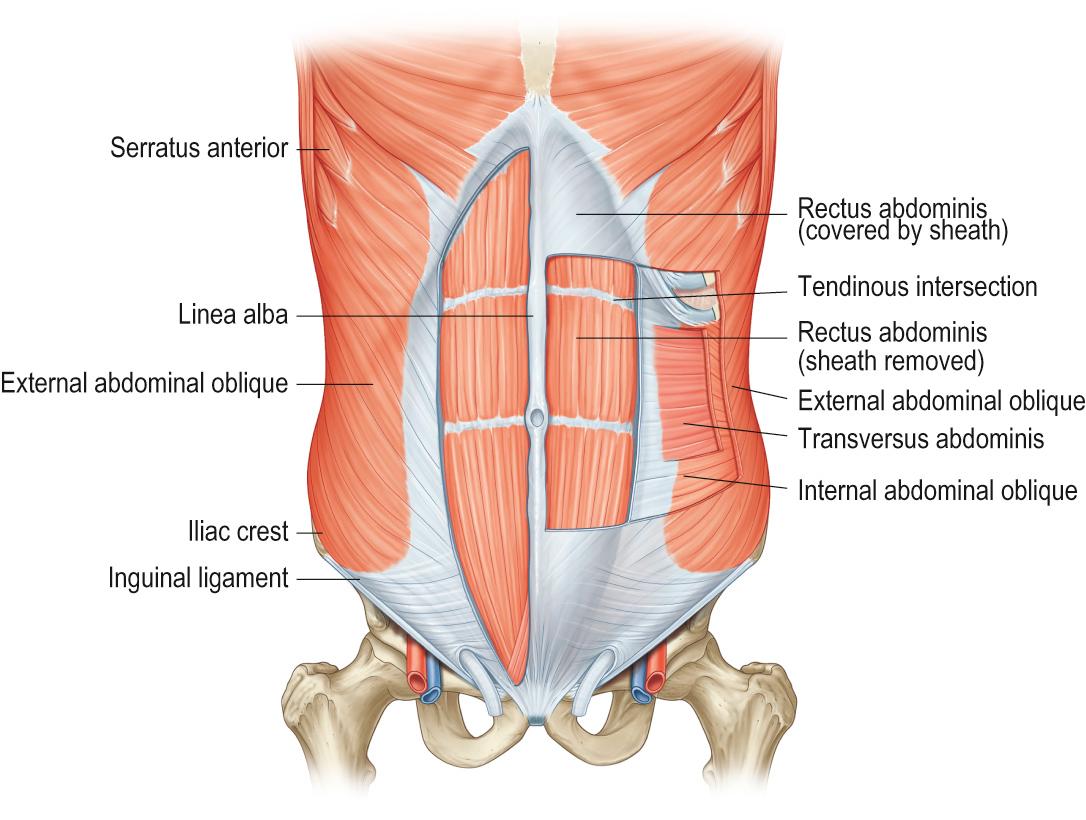
The first four lumbar ventral roots, together with a contribution from the twelfth thoracic ventral root (the dorsolumbar nerve), form the lumbar plexus ( Ch. 76 ); a sound understanding of their location relative to the vertebral body and disc space at each level is essential to minimize the risk of iatrogenic nerve injury during the transpsoas approach. The lumbar plexus lies in a coronal plane that is in line with the posterior part of the vertebral body at L1 but becomes more anterior in the lower lumbar spine. The L1 ventral root gives rise to the ilioinguinal and iliohypogastric nerves, which pass inferolaterally, initially anterior to quadratus lumborum, before piercing the muscle near the anterior superior iliac spine. The L1 and L2 ventral roots give rise to the genitofemoral nerve, which descends obliquely forwards through psoas to emerge on its anterior surface nearer the medial border, opposite L3 or L4. It then descends beneath the peritoneum on psoas major, crosses obliquely behind the ureter, and divides into genital and femoral branches; it may divide close to its origin such that its branches emerge separately from psoas major. The L2, L3 and L4 roots give rise to the obturator and femoral nerves. The femoral nerve can be injured during the transpsoas approach, causing transient or permanent quadriceps weakness. Part of the ventral root of L4 and all of the ventral root of L5 form the lumbar part of the lumbosacral trunk, which appears at the medial margin of psoas major and descends over the pelvic brim, anterior to the sacroiliac joint, to join the S1 root ( Fig. 34.8 ; see Fig. 34.6 ).
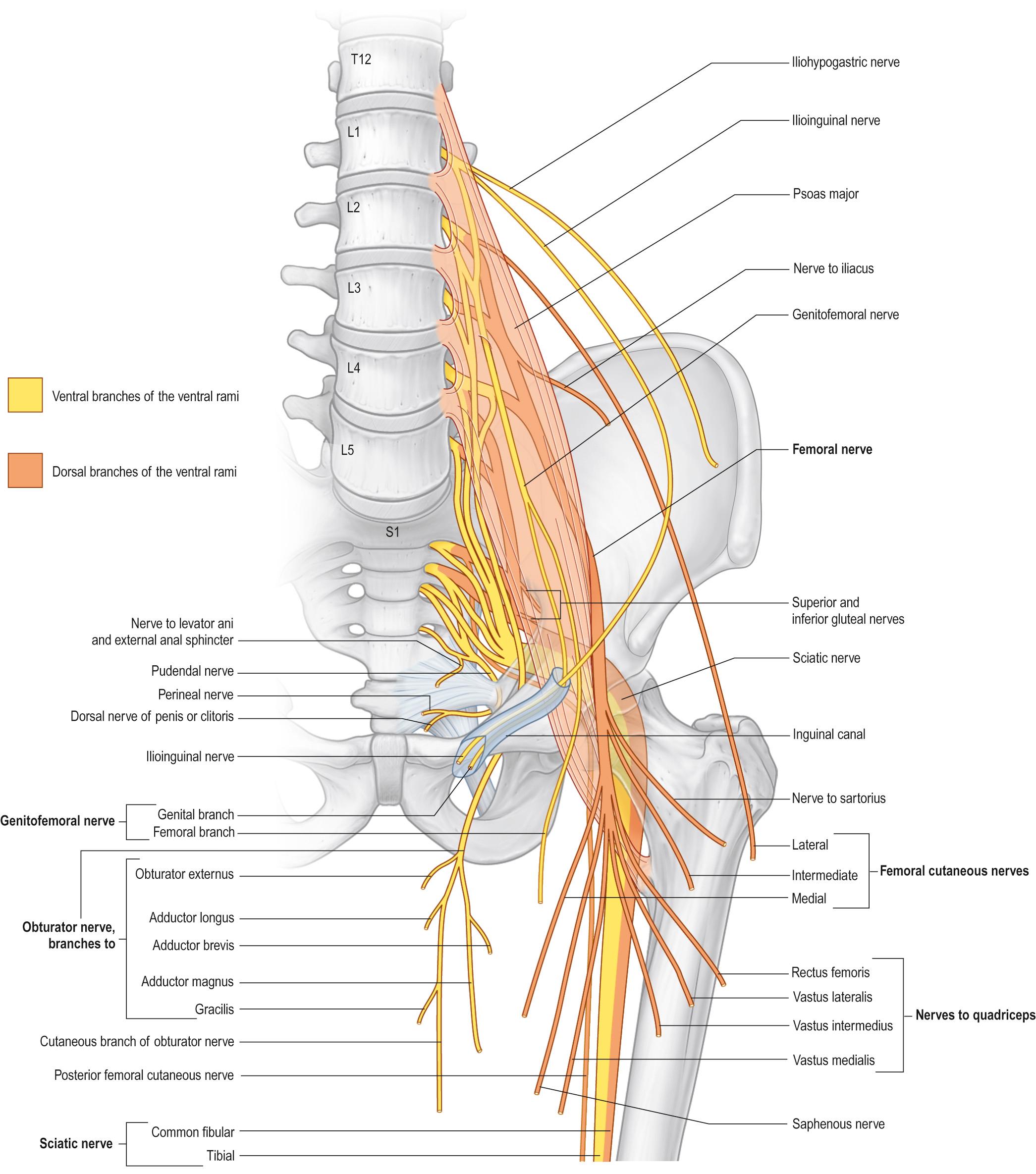
The aorta enters the abdomen through the aortic hiatus in the diaphragm at the level of T12 and bifurcates into the common iliac arteries, typically at the level of L4. The superior hypogastric plexus lies anterior to the aortic bifurcation, the left common iliac vein, median sacral vessels, fifth lumbar vertebral body and sacral promontory, and between the common iliac arteries ( Fig. 34.9 ). Iatrogenic injury to the sympathetic component of the superior hypogastric plexus during anterior lumbar interbody fusion (ALIF) exposure can lead to retrograde ejaculation as a result of disruption of the sympathetic supply to the bladder neck. Anterior radiculomedullary feeder arteries, derived from spinal branches of the lumbar arteries, anastomose with the anterior spinal arteries to form a single or partly double longitudinal vessel of uneven calibre along the ventral median fissure. The largest anterior medullary feeder, the great anterior radiculomedullary artery of Adamkiewicz, varies in level, arising from a spinal branch of either one of the lower posterior intercostal arteries (T9–11), or of the subcostal artery (T12) or, less frequently, of the upper lumbar arteries (L1 and L2). It most often arises on the left side ( Fig. 34.10 ).
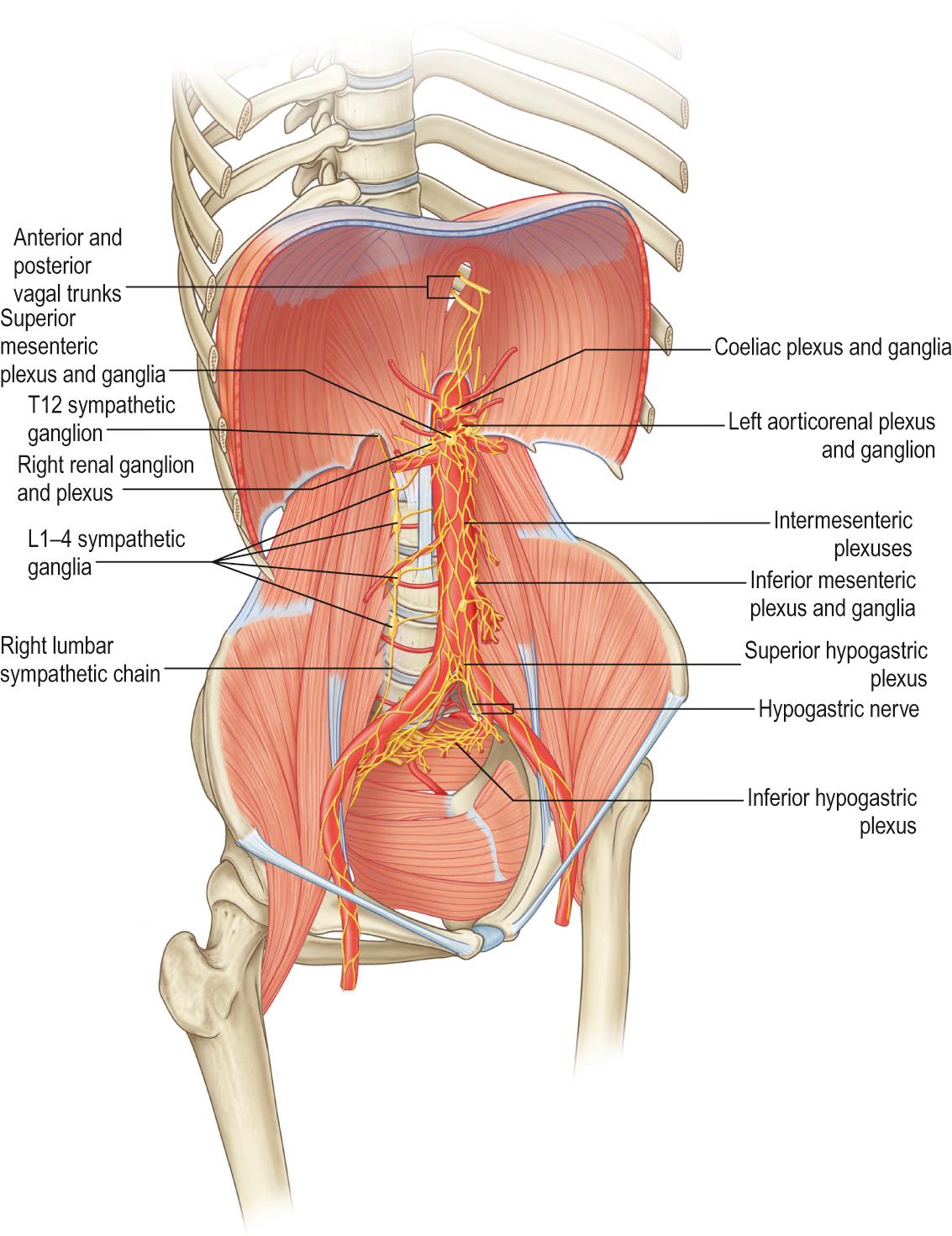
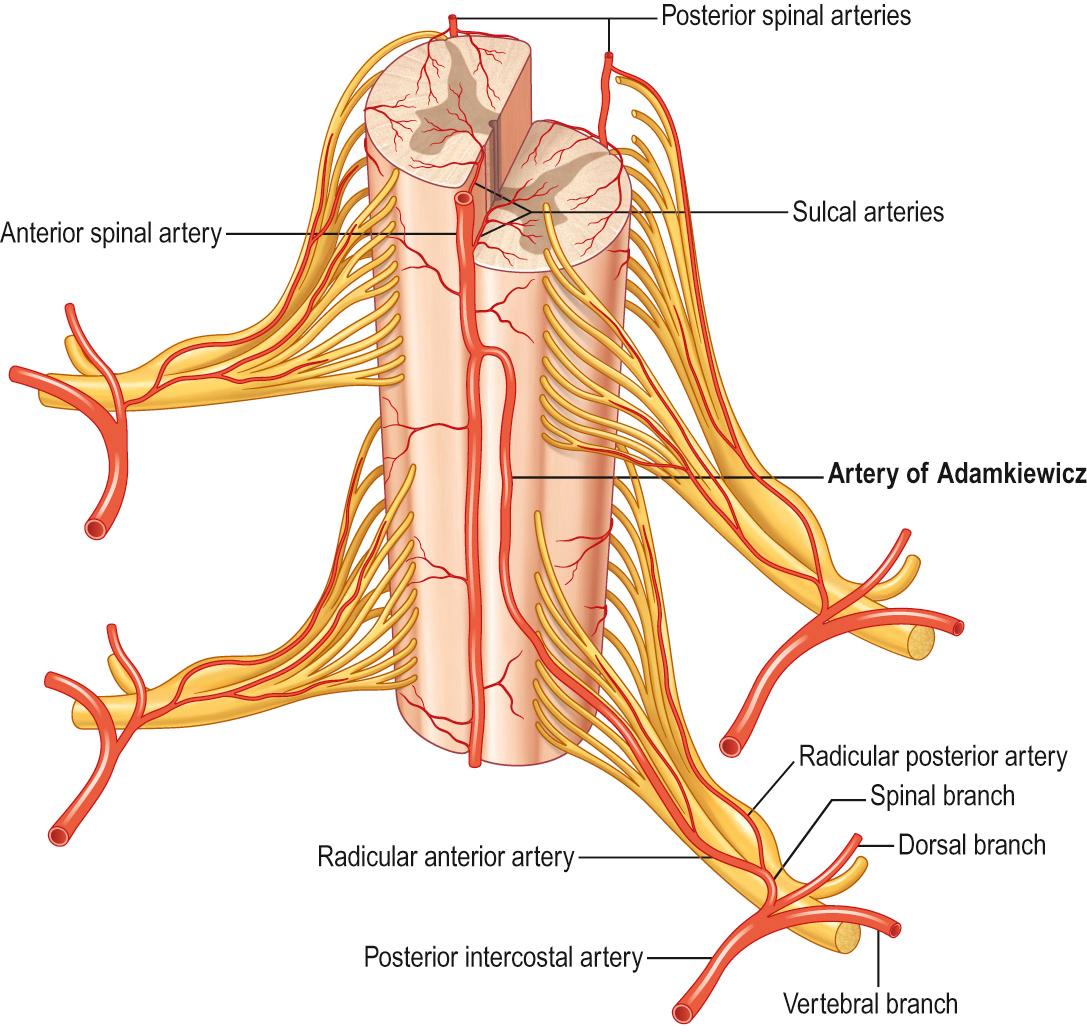
The inferior vena cava is formed by the two common iliac veins anterior and paramedian to the right of L5. Direct tributaries in the region include the lumbar veins, the right gonadal vein, the renal veins, the azygos vein and the right suprarenal vein. The left gonadal vein, the left suprarenal vein and the hepatic veins all drain into the left renal vein. The four or five paired lumbar veins are connected vertically by the ascending lumbar veins on each side, and drain into either the inferior vena cava or the common iliac veins. The right and left ascending lumbar veins are located dorsal to psoas major and join the right and left subcostal veins to form the azygos and hemiazygos veins, respectively ( Fig. 34.11 ).
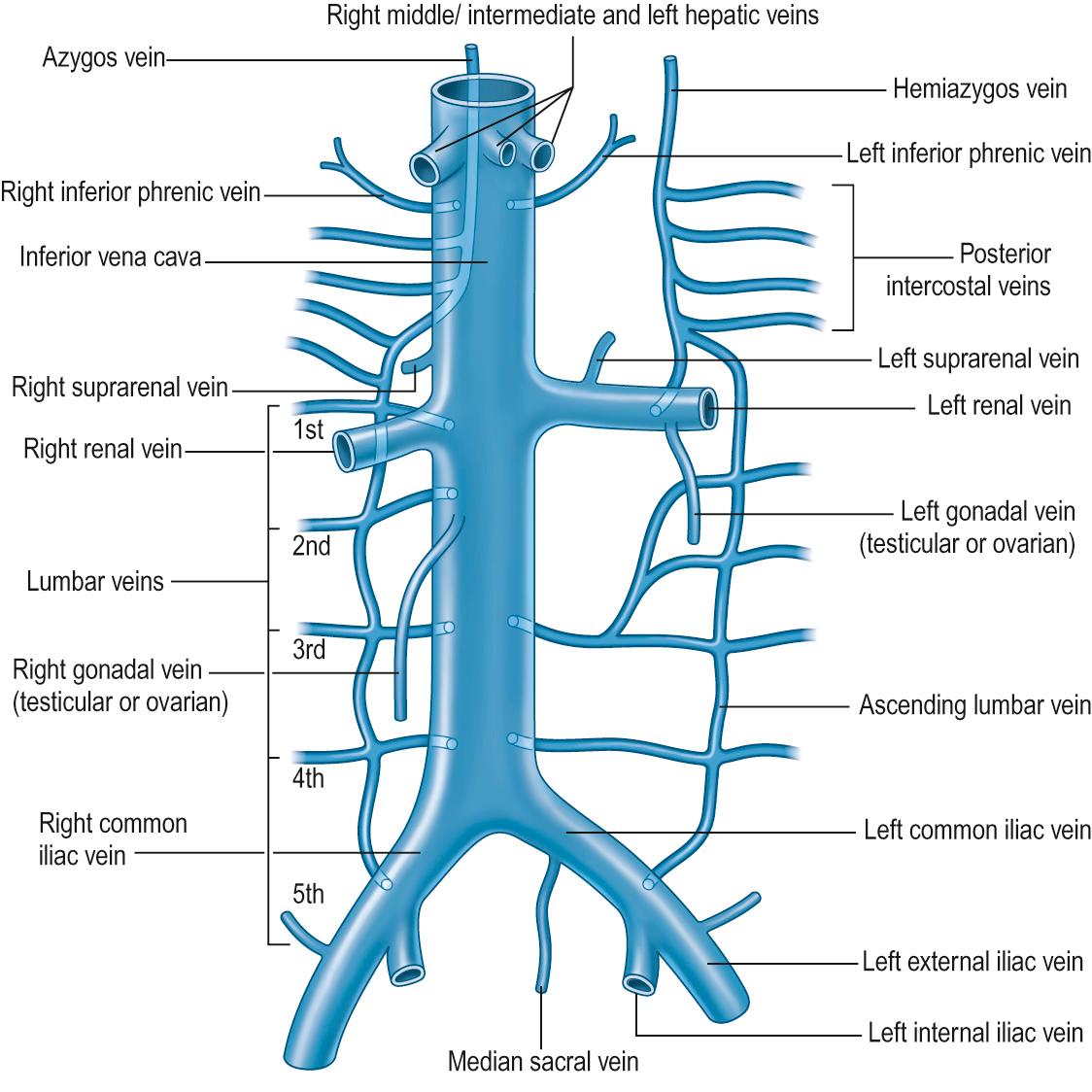
Become a Clinical Tree membership for Full access and enjoy Unlimited articles
If you are a member. Log in here